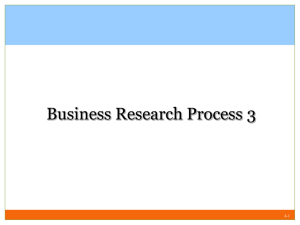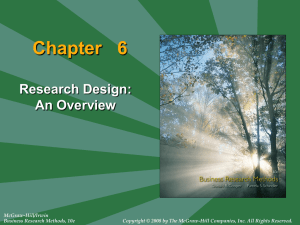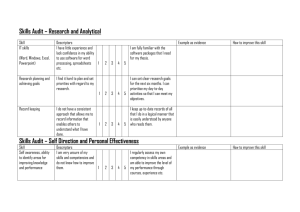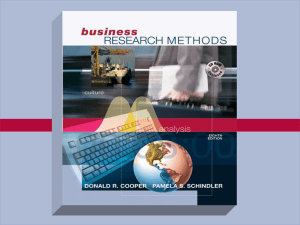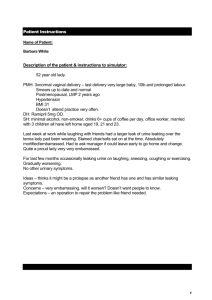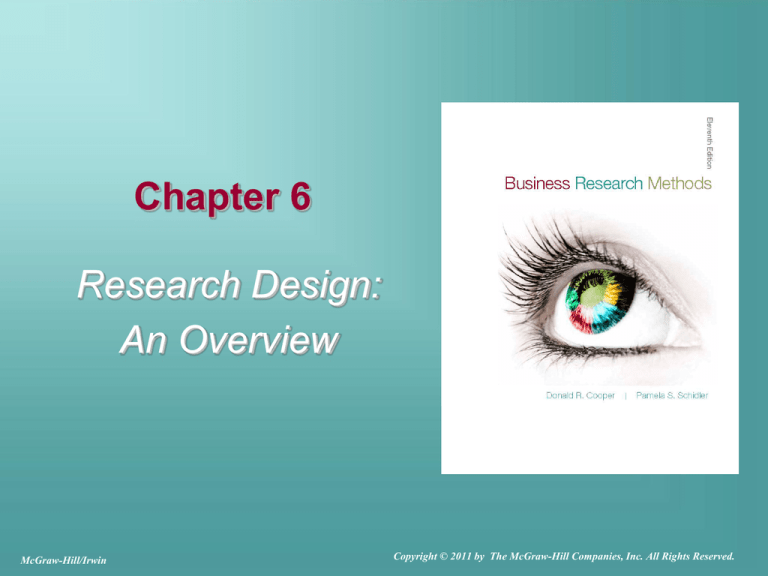
Chapter 6
Research Design:
An Overview
McGraw-Hill/Irwin
Copyright © 2011 by The McGraw-Hill Companies, Inc. All Rights Reserved.
Learning Objectives
Understand . . .
• The basic stages of research design.
• The major descriptors of research design.
• The major types of research designs.
• The relationships that exist between variables in
research design and the steps for evaluating
those relationships.
6-2
Research Guides Decisions
“Most human beings and most companies
don’t like to make choices. And they
particularly don’t like to make a few choices
that they really have to live with.”
Alan Lafley
former president and chairman of the board
P&G
6-3
PulsePoint:
Research Revelation
76
The percent of mobile phone
subscribers worldwide who use SMS
text messaging.
6-4
What Is Research Design?
Blueprint
Plan
Guide
Framework
6-5
What Tools Are Used in
Designing Research?
6-6
What Tools Are Used in
Designing Research?
MindWriter
Project Plan
in Gantt chart
format
6-7
Design in the Research Process
6-8
Research Design Descriptors
Perceptual
Awareness
Purpose of
Study
Question
Crystallization
Descriptors
Data
Collection
Method
Experimental
Effects
Time
Dimension
Research
Environment
Topical Scope
6-9
Degree of
Question Crystallization
Exploratory Study
Loose structure
Expand understanding
Provide insight
Develop hypotheses
Formal Study
Precise procedures
Begins with
hypotheses
Answers research
questions
6-10
Approaches for
Exploratory Investigations
Participant observation
Film, photographs
Projective techniques
Psychological testing
Case studies
Ethnography
Expert interviews
Document analysis
Proxemics and Kinesics
6-11
Desired Outcomes of
Exploratory Studies
Established range and scope of possible
management decisions
Established major dimensions of
research task
Defined a set of subsidiary questions
that can guide research design
6-12
Desired Outcomes of
Exploratory Studies (cont.)
Develop hypotheses about possible
causes of management dilemma
Learn which hypotheses
can be safely ignored
Conclude additional research is
not needed or not feasible
6-13
Commonly Used
Exploratory Techniques
Secondary
Data Analysis
Experience
Surveys
Focus
Groups
6-14
Face-to-face
interaction—
one of the best
ways to learn
from
participants.
6-15
Experience Surveys
• What is being done?
• What has been tried in the past with or
without success?
• How have things changed?
• Who is involved in the decisions?
• What problem areas can be seen?
• Whom can we count on to assist or
participate in the research?
6-16
Focus Groups
Group discussion
6-10 participants
Moderator-led
90 minutes-2 hours
6-17
Research Design Descriptors
Perceptual
Awareness
Purpose of
Study
Question
Crystallization
Descriptors
Data
Collection
Method
Experimental
Effects
Time
Dimension
Research
Environment
Topical Scope
6-18
Data Collection Method
Monitoring
Communication
6-19
Research Design Descriptors
Perceptual
Awareness
Purpose of
Study
Question
Crystallization
Descriptors
Data
Collection
Method
Experimental
Effects
Time
Dimension
Research
Environment
Topical Scope
6-20
The Time Dimension
Cross-sectional
Longitudinal
6-21
Research Design Descriptors
Perceptual
Awareness
Purpose of
Study
Question
Crystallization
Descriptors
Data
Collection
Method
Experimental
Effects
Time
Dimension
Research
Environment
Topical Scope
6-22
The Topical Scope
Statistical Study
Breadth
Population
inferences
Quantitative
Generalizable
findings
Case Study
Depth
Detail
Qualitative
Multiple sources of
information
6-23
Research Design Descriptors
Perceptual
Awareness
Purpose of
Study
Question
Crystallization
Descriptors
Data
Collection
Method
Experimental
Effects
Time
Dimension
Research
Environment
Topical Scope
6-24
The Research Environment
Field conditions
Lab conditions
Simulations
6-25
Research Design Descriptors
Perceptual
Awareness
Purpose of
Study
Question
Crystallization
Descriptors
Data
Collection
Method
Experimental
Effects
Time
Dimension
Research
Environment
Topical Scope
6-26
Purpose of the Study
Reporting
Casual Explanatory
Descriptive
Causal Predictive
6-27
Descriptive Studies
Who?
How much?
What?
When?
Where?
6-28
Descriptive Studies
Descriptions of population
characteristics
Estimates of frequency of
characteristics
Discovery of associations
among variables
6-29
Research Design Descriptors
Perceptual
Awareness
Purpose of
Study
Question
Crystallization
Descriptors
Data
Collection
Method
Experimental
Effects
Time
Dimension
Research
Environment
Topical Scope
6-30
Experimental Effects
Ex Post Facto
Study
After-the-fact report
on what happened to
the measured
variable
Experiment
Study involving the
manipulation or
control of one or
more variables to
determine the effect
on another variable
6-31
Ex Post Facto Design
Fishing Club Member
Non-Fishing-Club Member
Age
High
Absentee
Low Absentee
High
Absentee
Low Absentee
Under 30 years
36
6
30
48
30 to 45
4
4
35
117
45 and over
0
0
5
115
6-32
Causation and Experimental Design
Control/
Matching
Random
Assignment
6-33
Mills Method of Agreement
6-34
Mills Method of Difference
6-35
Causal Studies
Symmetrical
Reciprocal
Asymmetrical
6-36
Understanding
Casual Relationships
Property
Behavior
Disposition
Response
Stimulus
6-37
Asymmetrical Casual
Relationships
Stimulus-Response
PropertyDisposition
PropertyBehavior
Disposition-Behavior
6-38
Types of Asymmetrical Causal
Relationships
Relationship
Type
Nature of
Relationship
Examples
Stimulus-response
An event or change
results in a response from
some object.
• A change in work rules leads to a higher level
of worker output.
• A change in government economic policy
restricts corporate financial decisions.
• A price increase results in fewer unit sales.
Propertydisposition
An existing property
causes a disposition.
• Age and attitudes about saving.
• Gender attitudes toward social issues.
• Social class and opinions about taxation.
Dispositionbehavior
A disposition causes a
specific behavior.
• Opinions about a brand and its purchase.
• Job satisfaction and work output.
• Moral values and tax cheating.
Property-behavior
An existing property
causes a specific
behavior.
• Stage of the family life cycle and purchases
of furniture.
• Social class and family savings patterns.
6-39
• Age and sports participation.
Evidence of Causality
Covariation between
A and B
Time order of events
No other possible
causes of B
6-40
Research Design Descriptors
Perceptual
Awareness
Purpose of
Study
Question
Crystallization
Descriptors
Data
Collection
Method
Experimental
Effects
Time
Dimension
Research
Environment
Topical Scope
6-41
Participants’ Perceptional
Awareness
No deviation perceived
Deviations perceived
as unrelated
Deviations perceived as
researcher-induced
6-42
Research Design Descriptors
Category
Options
The degree to which the research question has been
crystallized
• Exploratory study
• Formal study
The method of data collection
• Monitoring
• Communication Study
The power of the researcher to produce effects in the
variables under study
• Experimental
• Ex post facto
The purpose of the study
• Reporting
• Descriptive
• Causal-Explanatory
• Causal-Predictive
The time dimension
• Cross-sectional
• Longitudinal
The topical scope—breadth and depth—of the study
• Case
• Statistical study
The research environment
• Field setting
• Laboratory research
• Simulation
The participants’ perceptional awareness of the research
activity
• Actual routine
• Modified routine
6-43
Key Terms
• Asymmetrical
relationship
• Case study
• Causal study
• Causation
• Children’s panels
• Communication study
• Control
• Control group
• Correlation
•
•
•
•
•
•
•
•
•
•
Cross-sectional study
Descriptive study
Ethnographic research
Ex post facto design
Experience
Experiment
Exploratory study
Field conditions
Focus group
Formal study
6-44
Key Terms (cont.)
• Individual depth
interview
• Intranet
• Laboratory conditions
• Longitudinal study
• Matching
• Monitoring
• Primary data
•
•
•
•
•
•
•
•
Qualitative techniques
Random assignment
Reciprocal relationship
Research design
Secondary data
Simulation
Statistical study
Symmetrical relationship
6-45

